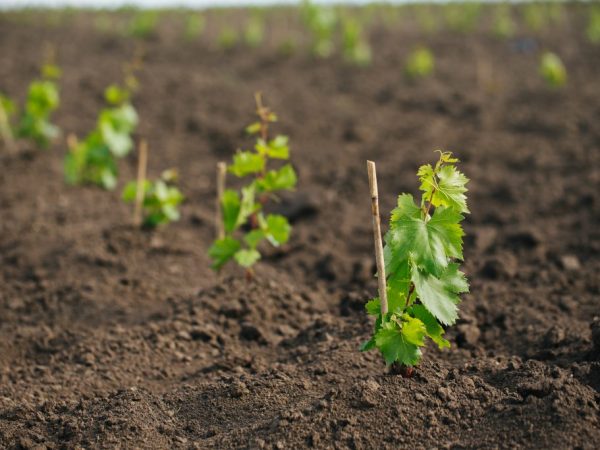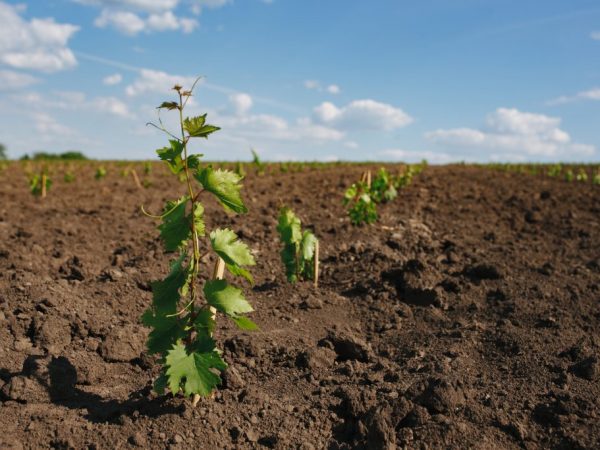Transplanting grapes in spring
Grapes belong to the category of particularly demanding plants in the care. For a good harvest, transplanting grapes in the spring is necessary.

Transplanting grapes in spring
Why transplant grapes
Spring transplanting of grapes increases the fruiting and resistance of the bush to frost and drought.
Young vine up to 5 years old reacts most painlessly when transplanting to a new place. They quickly adapt to new conditions and give a full harvest in a few years. It is more difficult to transplant an adult bush: at the age of about 7-10 years, it takes more time for it to adapt.
The main reasons for culture transplantation are:
- poor growth in the designated area;
- redevelopment or sale of a site;
- improperly selected neighbor plants.
Successful plant movement ensures good survival and high yields. It is recommended to replant a young vine in the spring, from April 25 to April 29, while focusing on meteorological forecasts. Each reason for transplanting requires adherence to the rules for moving the vine to another place.
Grape transplant rules

We comply with the transplant rules
To transplant the vine less painfully, a number of rules are followed:
- Soil preparation and heating. In the fall, the soil where the bush will grow is fertilized with ash, humus and minerals. Before planting itself, the pit is watered with warm water. A solution of potassium permanganate is used until the earth turns dark red.
- The plant is dug in at a distance of 50 cm from the base of the bush, gradually deepening.
- Pruning a bush. After freeing the plant from the ground, the old root branches, the tops of the branches are cut off. The vine is cut to 2 sleeves.
- Before transplanting, the root system is dipped into a clay-manure solution. For this, 2 kg of cow dung and 1 kg of clay are diluted in water to a liquid consistency.
- Inflorescence cleaning. During the period of plant engraftment, the inflorescences break off. In the second year, the third part of the inflorescence is left.
- It is not recommended to replant the vine in the old place. Death or frequent infection with diseases is possible.
For a new place, choose soil with sand, small stones and clay. The preparation of a new place is taken care of in the fall. The hole is dug deep enough: to a depth of about 55 cm, so that the plant can easily fit with the entire root into the hole. If you transplant several bushes, the pits are placed at a distance of 2-2.5 m from each other.
Transplant methods
To transplant a vine, it is not necessary to dig up a plant, because there are several ways
| room | Transplant method | Description |
| 1 | Open root system | After digging, the plant is freed from the old soil with the help of a wooden peg, without injuring the root system. After the pruner, old roots are removed to cleanse or renew the root. |
| 2 | Transshipment | The vine, together with the earthen clod, is transferred to a new pit. So that a clod of earth does not crumble, the plant is not watered a week before transplanting. This method is suitable for bushes from 3 to 5 years old. |
| 3 | Cuttings | Grafting cuttings to the vine. The shoots are harvested in September, after pruning an adult bush.Until winter, the cuttings obtained during pruning are stored in the sand, after which all buds are removed and planted in a new place. In the first weeks of growth, the seedling is watered abundantly. |
| 4 | Layers | It is used for mature plants that live for over 10 years. To do this, the cuttings from the bush are moved a short distance, added dropwise and watered. The established and rooted cuttings are separated from the mother plant. |
To plant cuttings in open ground, they are expected to be at least 7-10 mm in diameter. Spring transplanting is characterized by the preparation of a pit for transplanting to another place and cuttings if an adult bush is moved.
Grape care
Appropriate care when transplanting a plant allows you to get a large number of berries and protect the bush from pests and diseases. It is impossible to water the plant during flowering and ripening. Summer and dry spring are considered suitable periods for abundant watering. In the summer, each bush has about 15 liters of water. Abundant watering is stopped at the end of August.
In winter, after transplanting, the bush is covered. In the first months after planting in a new place, the root of the vine is still weak and requires protection from frost. For shelter, earth, spruce branches, non-woven materials are suitable. For small bushes, use plastic bottles without a neck. They are put on a plant and sprinkled with earth.
Top dressing
If fertilizers were applied to the soil during transplantation, the bush does not need feeding for the first 2 years. Foliar dressing is used 7 times a season.
Transplanted bushes need to be fertilized about 2-3 times throughout the summer with regular periodic loosening of the soil around the bush
Correctly selected fertilizers for the soil contribute to the survival of the bush in a new place.
| room | Top dressing for the soil | Dosage per 1 sq. m |
| 1 | Humus | 5-7 kg |
| 2 | Wood ash | 250 g |
| 3 | Ammonium sulfate | 150 g |
| 4 | Superphosphate | 300 g |
| 5 | Potassium salt | 40 g |
Once a year, the plant is fertilized with organic elements: compost or manure. To do this, use 6-8 kg of substance per 1 sq. m. Soil mulching ensures the preservation of moisture in the soil and the destruction of weeds. Ash from vines is also considered a suitable fertilizer. It is used at the rate of 25-30 g per 1 sq. m.
Disease and pest control
The most common vine diseases are powdery mildew, alternaria and black spot, which infect leaves and berries. The main prophylaxis against diseases is carried out when the plant reaches a length of 25 cm. To do this, take a solution of copper sulfate in milk of lime, the drug "Actellik". It is diluted at the rate of 20 ml of substance per 10 liters of water. "Abiga-Peak" is used at the rate of 40 g per 10 liters of water.
Dangerous pests for bushes: phylloxera, leafworm, grape and spider mites. To combat them, pruning and spraying is carried out. The drugs are used:
- "Speed" at the rate of 2 ml per 10 liters of water;
- "Hom" - 40 g per 10 liters of water;
- "Raek" - 2 ml per 10 liters of water;
- "Fufanon" - 10 ml per liter of water.
To combat diseases and pests, the bush is treated with a soap or ash solution. For this, 300 g of soap or ash are mixed with 10 liters of water.
Conclusion
Growing grapes is a laborious process. To properly transplant the bush in the spring, you need to follow the recommendations. Thanks to this, the vine will give tasty and juicy berries already for 3 years.

